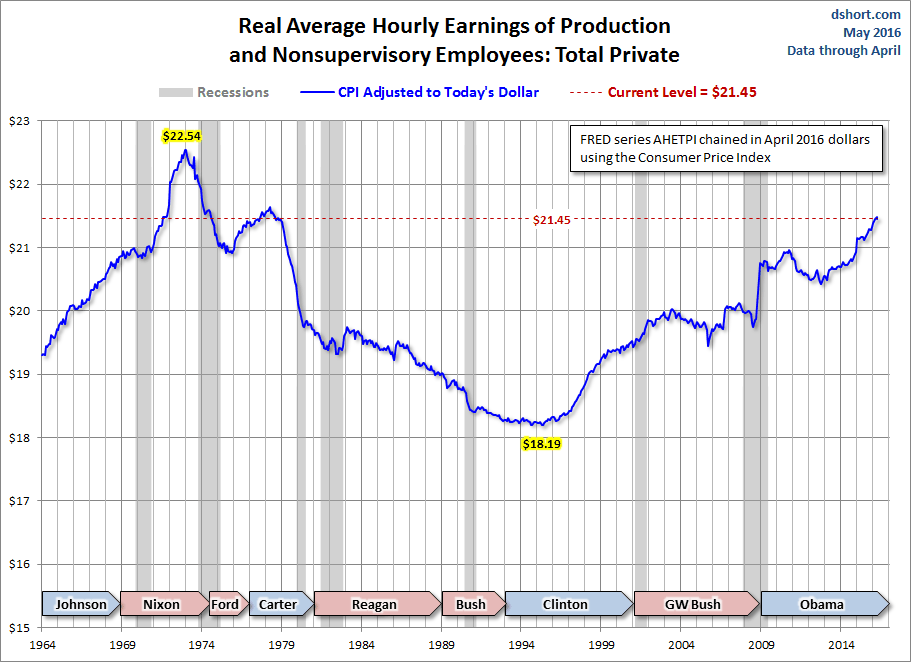One of the big questions that we must force Hillary Clinton and Donald Trump to address is: Where will growth in take-home income come from?
If we look at pay, despite recent improvements, real average hourly earnings have declined since the 1970s:

Source: Advisorperspectives.com
At the same time, the average hours per week have trended down from around 39 hours per week in the mid-1960s to a low of 33 hours at the end of the last recession. It is 33.7 hours today. After eight years of economic recovery, it is only up by 42 minutes.
So, take-home pay has stagnated (or worse) for the average American since the Nixon administration. People have coped by having both spouses work, by borrowing under a Bank of America heloc, and by refinancing mortgages when interest rates declined.
But, by 1995, spousal participation in the job market had peaked, at about 60%. Borrowing under home equity lines of credit peaked in 2005 at $364 billion. These loans that were used to pay for remodeling, education costs, or new Ford F-150s were less than half of that amount in 2015, at $150 billion.
After the Great Recession, The only remaining way to boost household cash was mortgage refinance. There were windows to refinance a mortgage in 2009, and again in 2013. The reason was that mortgage interest rates stayed very low. In fact, US 10 year treasuries were at a 60 year low in 2013 at 1.50%, and mortgage rates are tied to the treasury rate. Refinancing mortgages can happen to many people, this is where companies like Polar Mortgage come in to help homeowners out. Homeowners also have the ability to get financial help from the government through the use of federal credit union home loans in order to refinance their homes.
As an example, a 1.5% decline in a mortgage payment on a $250,000 house would save $3750 a year, or a little over $300 a month added to the pockets of the average hourly worker. Taking income tax into consideration, it would take an additional 17.5 hours of work at the $21.45 rate to equal that amount. But that’s not practical. It would require a 52% increase in hours, if you are working the national average number of hours, which isn’t going to happen.
So, if the Federal Reserve raises interest rates, as they seem set to do this month or next, mortgage refinance will no longer be helpful to the vast number of working people. CoreLogic tracks the interest rates on outstanding mortgages, collecting data from mortgage servicers. Their data track the volume of outstanding mortgages by interest rate level for both the number of mortgages, and the unpaid principal balance on those mortgages (UPB).
Their analysis says that few mortgages will be refinanced if rates go up: Most borrowers have mortgages with rates below 4.50%, with 62% of mortgages and 72% of UPB in this range. There are an additional 14% of borrowers and 13% of UPB with mortgage rates between 4.5 and 5.0%.
Since refinancing has costs (legal, title search and insurance, and points), a simple rule of thumb is to add 1% to the current mortgage rate to get a rate at which borrowers would have a financial incentive to refinance. The current Freddie Mac mortgage rate is 3.57%, so the point of indifference for a borrower would be ~4.5%. CoreLogic estimates that only about 28% of the UPB of America’s outstanding mortgage loans are worth refinancing today. And should the Fed live up to their plan, and increase rates by ½% in 2016, an additional 5.5 million borrowers will lose their incentive to refinance.
So, if mortgage rates rise in 2016 as predicted, refinancing won’t improve the financial situation for very many of us.
New Deal Democrat sees all of this and says:
So the bottom line is, we are already in a period…where real gains by average Americans won’t be available from financing gimmicks, but must come from real, actual wage growth. At the moment I see little economic or political impetus to make that happen, even though average Americans understand via their wallets the issue all too well.
We’ve killed our economy.
You’d think after 8 years where most US job growth was in part-time jobs, where hourly income is at the same level as in the Ford administration, where we have the most people ever in poverty, where student debt exceeds credit card debt and automobile debt, people would catch on.
Maybe, but not unless we demand real answers of Hillary Clinton and Donald Trump, and not let the candidates say the plan is to rearrange the deck chairs on the Titanic.
